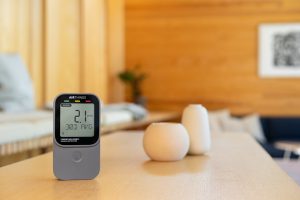Hazardous wildfire smoke can have a terrible impact on our health and wellbeing. Each summer, in particular, Canadians see it on TV, in our cities and, sometimes, in our homes. But there are particles that cannot be seen easily so what can be done?
Norwegian company, Airthings, recently conducted a data analysis of particulate matter (PM 2.5) levels in homes throughout Canadian cities – Toronto, Winnipeg, Saskatoon, and Regina -during the recent stretch of wildfires in June, and the results saw spikes in PM 2.5 more than double the recommended maximum threshold of WHO guidelines.

Erica Karlsen, Airthings
I connected with Erica Karlsen, Product Marketing Manager and Air Quality Expert at Airthings , about its research and app-based home platform and what Canadians can do to mitigate poor air quality in their homes.
Wildfire Impact and Recent Research
“As we’ve all seen, wildfires are unfortunately becoming more prevalent and devastating in scale, especially in Canada,” stated Karlsen. “With this trend only continuing to grow each year, residents must adjust their preparedness accordingly.”
“When we think about wildfires, the obvious focus is on the immediate areas affected and damaged by the fire itself. However, wildfire smoke is a hidden threat that should be taken just as seriously,” explained Karlsen.
“Wildfire smoke has been proven capable of traveling thousands of miles from its origin and contains harmful pollutants and microscopic particles that can be severely detrimental to our respiratory health,” shared Karlsen. “Children, who are more susceptible to the adverse effects because their lungs aren’t fully developed, are especially vulnerable.”
“This is where our recent research comes in,” began Karlsen.
“Many people think that they can mitigate wildfire smoke simply by keeping their home’s windows and doors closed, but this is a dangerous misconception. We’ve learned that wildfire smoke particles can penetrate through extremely small openings and even building materials, meaning closing windows and doors is not enough.”
Airthings Making Its Mark in Canada
“Airthings was founded in Norway in 2008 with a simple mission: to help people breathe better and live better,” shared Karlsen. ”Over the years, Airthings has developed accessible technology solutions to help people stay healthy by educating them on the prevalence of radon and other indoor air contaminants.”
“Today, Airthings is a global tech company led by a team of experienced scientists, engineers, developers and visionaries, collectively focused on helping improve people’s lives through simple, scalable air quality solutions,” said Karlsen.
 “In Canada, Airthings has a significant footprint in the consumer, corporate and commercial segments,” said Karlsen. ”Local residents can find Airthings products in person at stores like Best Buy and Canadian Tire, as well as online through sites like Amazon Canada and Airthings.com.”
“In Canada, Airthings has a significant footprint in the consumer, corporate and commercial segments,” said Karlsen. ”Local residents can find Airthings products in person at stores like Best Buy and Canadian Tire, as well as online through sites like Amazon Canada and Airthings.com.”
Added Karlsen, “Canadians can also find Airthings monitors through one of the many library lending programs that Airthings participates in throughout Canada. These local libraries offer free rentals of Airthings’ radon detection products so that residents can gain insight into the radon levels in their homes.”
Remarked Karlsen, “Airthings has played a major role in improving air quality in schools in Canada. In 2021, Airthings was awarded a 10-year contract to supply air quality monitoring solutions to all private schools across Quebec, one of Canada’s largest provinces.
Airthings Technology
I asked Karlsen about her app-based user platform and any connected home functionality to which Karlsen responded, “Airthings makes air quality easier than ever to visualize and understand by supplementing its monitoring products and purifiers with the intuitive Airthings app, which is free to download.”
“The Airthings app provides a connected experience that allows users to customize and build out a whole-home ecosystem for air quality monitoring,” explained Karlsen. “By syncing an Airthings product with the Airthings app, users can gain daily and long-term insights and alerts into their personal air quality levels, and also further contextualize their data through a host of in-app features and tools.”
 Karlsen added, “Airthings products offer connectivity with several outside platforms, including Google Home, Amazon Alexa, IFTTT, Homey, and Raspberry Pi. Many smart home fans create their own “recipes” where they can trigger on their fans, ventilation, purifiers, or other connected devices when their Airthings products report levels at certain thresholds.”
Karlsen added, “Airthings products offer connectivity with several outside platforms, including Google Home, Amazon Alexa, IFTTT, Homey, and Raspberry Pi. Many smart home fans create their own “recipes” where they can trigger on their fans, ventilation, purifiers, or other connected devices when their Airthings products report levels at certain thresholds.”
Air Pollutant Protections
“While wildfire smoke and other air pollutants can seem scary, it’s important that Canadians know that there are many solutions and steps available to protect themselves and their families,” advised Karlsen.
“The most important thing they can do is to gain an understanding of their own indoor air quality so that they can diagnose whether they have an issue or not,” suggested Karlsen. “An air quality monitor, such as our View Plus, can serve as a highly accurate, all-in-one solution for visualizing the air quality levels inside your home over time.”
Karlsen went on to say, “We also recommend that people take air purification seriously, no matter what type of home structure or location they live in. Our Renew air purifier has a built-in particulate matter sensor and a HEPA-13 filter that removes 99.97% of airborne pollutants, including the ones most commonly found in wildfire smoke. However, several great solutions are on the market, ranging from purifiers to whole-home HVAC systems, so it’s best to research what products make the most sense for your space.”
“Finally, we encourage residents to visit all of the excellent, free online resources that regularly track wildfire smoke PM 2.5 levels, such as this live map from the Canadian government,” stated Karlsen.
-30-
Related: Wildfire tools



